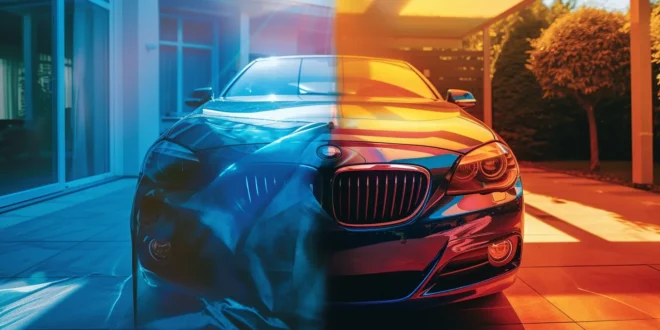When it comes to protecting your vehicle from the harsh effects of sunlight, car covers have become a popular solution. Car covers shield vehicles from UV rays, dust, and dirt, helping to maintain their appearance and prolong their lifespan. However, the color of the car cover can influence its effectiveness in reflecting sunlight. In this guide, we will explore the question: Do blue car covers reflect sunlight? We will examine the factors that affect a car cover’s ability to reflect sunlight, the benefits of different colors, and practical tips for choosing the best cover for your needs.
1. Understanding the Importance of Sunlight Reflection
Why Sunlight Reflection Matters for Car Covers
Sunlight can be detrimental to a vehicle’s exterior and interior. Prolonged exposure to UV rays can cause paint fading, clear coat deterioration, and interior materials to degrade over time. Additionally, excessive heat can lead to discomfort when entering the vehicle and can even affect sensitive components under the hood.
Choosing a car cover that reflects sunlight is crucial for mitigating these effects. An effective car cover can lower the interior temperature of your vehicle, protect the paint from fading, and prolong the life of both the exterior and interior materials.
2. The Science Behind Color and Light Reflection
How Color Affects Heat Absorption and Reflection
The color of a car cover plays a significant role in its ability to reflect sunlight. Light colors, such as white and silver, are known for their reflective properties, while darker colors, like black or dark blue, tend to absorb more heat. This principle is rooted in the science of light absorption and reflection.
When light strikes an object, it can either be absorbed or reflected. Lighter colors reflect more sunlight, preventing heat buildup, while darker colors absorb more sunlight, resulting in increased temperatures. Therefore, it is essential to consider how the color of a car cover can influence its performance in sunlight.
3. Do Blue Car Covers Reflect Sunlight?
Examining the Reflective Properties of Blue Covers
To address the question, do blue car covers reflect sunlight?, it is important to understand that the effectiveness of blue car covers can vary based on several factors, including:
- Shade of Blue: The specific hue of blue can impact its reflective properties. Lighter shades of blue may reflect sunlight more effectively than darker shades. For instance, a pastel blue cover will likely reflect more sunlight than a navy blue one.
- Material Composition: The material used in a car cover also influences its reflective properties. Some materials, like reflective polyethylene or specially coated fabrics, enhance sunlight reflection regardless of color. Therefore, a blue car cover made from high-quality, reflective material may perform better than a standard cover, even if it is darker in color.
- UV Protection Features: Many car covers come with UV protection ratings. These ratings indicate how well the material can shield your vehicle from harmful UV rays. A blue car cover with a high UV rating may provide better overall protection than a lower-rated cover, irrespective of color.
4. Benefits of Using a Blue Car Cover
The Aesthetic and Functional Advantages
While the reflective properties of blue car covers may vary, they offer several advantages worth considering:
- Aesthetic Appeal: Blue is a popular color for car covers, often complementing a wide range of vehicle colors. A blue car cover can enhance the overall appearance of your vehicle, making it visually appealing when parked.
- Moderate Heat Absorption: Compared to darker colors, blue covers may absorb less heat, especially if they are lighter shades. This can help keep your car cooler in direct sunlight, although they may not perform as well as lighter colors like white.
- Visibility and Safety: Blue car covers are often more visible than darker covers, which can be beneficial when parked in crowded areas. Increased visibility can help prevent accidental dings and scratches from other vehicles.
5. Factors to Consider When Choosing a Car Cover
Making an Informed Decision
When selecting a car cover, it is essential to consider several factors beyond just color. Here are some critical aspects to evaluate:
- Material Quality: Look for high-quality materials that offer durability, breathability, and UV resistance. Materials like breathable polyester, woven fabric, or specialized reflective materials can provide better protection.
- Fit and Size: Ensure that the car cover fits your vehicle snugly. An ill-fitting cover can trap moisture and lead to mold or mildew buildup. Look for covers specifically designed for your car’s make and model.
- Weather Resistance: Consider the weather conditions in your area. If you live in a sunny climate, a cover with UV protection is essential. If you also face rain or snow, opt for a waterproof or weather-resistant cover.
- Ease of Use: Choose a car cover that is easy to put on and take off. Some covers come with elastic hems or straps to ensure a secure fit, making them easier to handle.
6. Maintenance and Care for Car Covers
Extending the Life of Your Car Cover
To ensure that your car cover remains effective over time, proper maintenance is essential. Here are some tips to help you care for your car cover:
- Regular Cleaning: Clean your car cover regularly to remove dirt, dust, and debris that can accumulate over time. Follow the manufacturer’s instructions for cleaning to avoid damaging the material.
- Storage: When not in use, store your car cover in a cool, dry place to prevent mold and mildew growth. Ensure it is completely dry before folding and storing.
- Check for Damage: Periodically inspect your car cover for signs of wear and tear, such as tears, fading, or loss of elasticity. Address any issues promptly to ensure continued protection.
7. Conclusion
In summary, while the color of a car cover, specifically blue, can influence its ability to reflect sunlight, other factors such as material quality, UV protection features, and the specific shade of blue also play vital roles. Lighter shades of blue may offer better reflective properties than darker ones, but they may not perform as well as lighter colors like white or silver.
When selecting a car cover, it is crucial to consider not just the color but also the quality of materials, fit, and features that best suit your vehicle and environmental conditions. By investing in a suitable car cover and maintaining it properly, you can protect your vehicle from the damaging effects of sunlight and keep it looking great for years to come.
Are you passionate about sharing your insights and expertise? We invite you to write for us! Whether you’re a seasoned writer or just starting out. We’re looking for fresh perspectives on a variety of topics, from lifestyle and wellness to technology and travel.
 Lifeyet News Lifeyet News
Lifeyet News Lifeyet News





